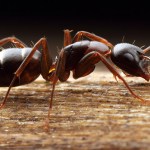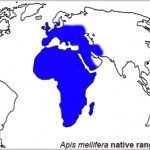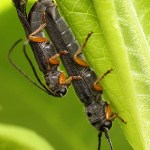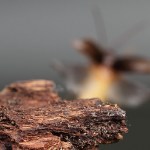
Something took a bite out of this leaf:
What was it?
Three points for the taxonomic order of the culprit, five for family, and two for explaining the natural history. Points are awarded only for the first correct guess in each category. And maybe some extra ones if you get creative with the natural history.
The cumulative points winner for the month of June 2010 will get their choice of 1) any 8x10 print from my photo galleries; or 2) a guest post on the safe-for-work topic of their choice.
Apropos of Paraguay's victory in this morning's world cup match against Slovakia, here's a photo I took almost 15 years ago:
This is a local match in the Paraguayan community where I lived as a Peace Corps volunteer. Our team, from Colonia 11 de Setiembre, beat Ype Jhu 2-1.
But that's not why I'm sharing the picture. Do you see all that dirt mounded up in the foreground? That's a mature nest of Atta sexdens, a leafcutter ant, right on the playing field.
I guess there are two points here. First, ants are an ubiquitous presence in Paraguay, getting into just about everything. It's a…
A dagger fly (Diptera: Empididae), eating a fly it caught.Shawnee National Forest, Illinois
Among the insects, one lineage in particular excels in the air: Diptera, the flies. These animals have evolved a gyroscopic control system that's faster and more efficient than the standard insect sensory system, and as a consequence the flies are the most agile fliers on our planet. Their numbers include some spectacularly maneuverable aerial predators such as the fly pictured here, hanging from a leaf to consume its prey.
Photographing these subjects posed two problems. First, flies are highly…
[The following is a guest post by Rob Mitchell]
Rob here, back again with your answer to this week's mystery... not that you need it! And here I thought I was being tricky. Six points to FormicidaeFantasy for hitting the order, family, and genus, and another four to Gordon Snelling for making quick work of the specific epithet.
This beetle is a female Neoclytus tenuiscriptus, an uncommon little denizen of the American southwest (or the Mexican northwest, depending on where you're standing). According to Hovore's '83 monograph, the larvae bore in Baccharis, and specifically, can be found…
I haven't posted any ants for awhile. So here is a pair of little carpenter ants from the back yard:
Camponotus nearcticus
Camponotus caryae
Most people in North America think of carpenter ants as the big hairy black things that damage houses by chewing through older and dry-rotted wood. That's certainly true of Camponotus pennsylvanicus, the eastern black carpenter ant.
But the genus contains many smaller and less conspicuous species that nest in pre-formed cavities and plant stems, foraging for scraps and honeydew and generally bothering no one. The two pictured here are both abundant…
[the following is a guest post from Rob Mitchell]
Hi folks - Rob Mitchell here, guest blogger extraordinaire and your temporary replacement for Alex while he celebrates a recent age-related milestone.
My job tonight is to provide you entomology sleuths with a mystery, so take a look here at exhibit A:
Who is this gangly gal? Let's say we give points for her order (1), family (2), genus (3), and species (4).
As always, the cumulative points winner for the month of June will win either 1) any 8x10 print from Alex's insect photo gallery, or 2) a guest blog post on the (safe-for-work) topic…
Glischrochilus sanguinolentus
Bell Smith Springs, Illinois
Just for you guys, here are some portraits of a colorful sap beetle in the family Nitidulidae I encountered in southern Illinois last weekend. It's a charming little insect, especially the cute, clubby antennae.
The challenge with shooting shiny insects such as Glischrochilus is lighting the insect without glare. The back of this animal is like a mirror, and if I were to just use the available sunlight or a bare camera flash all I'd get is a blown-out spot reflection of the light source with the rest of the animal appearing dark and…
You may have noticed I've been blogging rather lightly in recent weeks. That's because I start teaching an introductory course on beekeeping next Monday. It'll be a great class, I hope. But the preparation has cut into blogging time something fierce and will continue to do so through August.
In any case, while making lecture slides yesterday I ran into trouble locating a figure depicting the native range of Apis mellifera. You'd think someone would have posted one, somewhere. The western honey bee is the world's most economically important insect, introduced nearly everywhere where humans…
What was the strange insect that seemed a mutant cross between a bee and a beetle?
Rhipiphorus wedge-shaped beetle, ovipositing into an aster Shawnee National Forest, Illinois
Kudos and all 10 points go to coleopterist extraordinaire Ted MacRae of Beetles in the Bush, who provided the correct answer Coleoptera: Rhipiphoridae: Rhipiphorus .
Rhipiphorus is unusual for a beetle. Coleoptera counts few parasites among its hundreds of thousands of described species. But the wedge-shaped beetles are ectoparasites of bees. Adults can be found on flowers, laying eggs that hatch into little bee-…
Audubon's Ted Williams explains that staged images have taken over the animal photography business and argues that these ubiquitous phonies give the public an inaccurate view of nature:
Audubon has sent me to lots of wild places over the past 31 years, but I'd seen only one wolf and three cougars (a litter) until December 8, 2009. On that day, before noon in the Glacier National Park ecosystem of northwestern Montana, I encountered not just one wolf but two and not just one cougar but two! What were the chances of that?
Well, they were 100 percent, because I'd rented the animals for a photo…
Tonight's challenge is this rather unusual insect.
What is it?
Points will be awarded to the first person to pick the order (3), family (3), and genus (3). Plus, a bonus point for explaining what is unusual about this insect's life cycle.
The cumulative winner for the month of June 2010 will get their choice of 1) any 8x10 print from my photo galleries; or 2) a guest post on the safe-for-work topic of their choice.
Oberea flavipes, phlox stem borer beetlesIllinois
Here's a boring beetle.
That is, the larvae bore. They make their living carving tunnels through stems and consuming plant tissue. This pair was hanging out in the phlox in our back yard, apparently plotting the demise of our summer flower garden.
photo details:
Canon EOS 7D camera
Canon MP-E 65mm 1-5x macro lens
ISO 100, f/13, 1/250sec
diffused twin flash
Thanks to Rob Mitchell for the ID.
The bold, playful style of Graphocephala coccinea, the candy-striped leafhopper, is all the rage this season:
photo details:
Canon EOS 7D camera
Canon MP-E 65mm 1-5x macro lens
ISO 100, f/13, 1/250sec
diffused twin flash
Speed was essential to scoring points in yesterday's istockphoto taxonomy fail challenge. Commentator JasonC replied within minutes of the original posting with 8 answers correct to the appropriate level and is awarded 8 points. RobM and MarekB also picked up a point each for adding identifications of the Syrphid and the fire ant male.
Correct answers were considered those that identified the mystery insects to the same taxonomic level as the original iStockphoto misidentification:
Red Admiral
Robber Fly
Hemiptera
Crane Fly
Katydid
Cuckoo Wasp
Hornet (Vespa)
Drone Fly (Eristalis)
Sugar Ants…
With plumes of crude oil destroying the Gulf of Mexico, tensions rising in the middle east, a severe hurricane season reving up in the Atlantic, and the earth opening up and just plain swallowing parts of Guatemala City whole, what else could possibly go wrong?
A mormon cricket crosses the road, Nevada.
Well. How about a plague of locusts?*
The USDA has just announced that the conditions are ripe for a grasshopper outbreak in the northern great plains:
The U.S. Department of Agriculture's Animal and Plant Health Inspection Service (APHIS) is expecting potentially heavy grasshopper outbreaks…

















